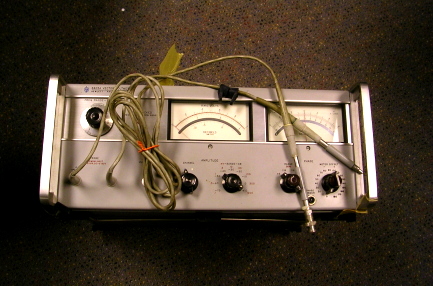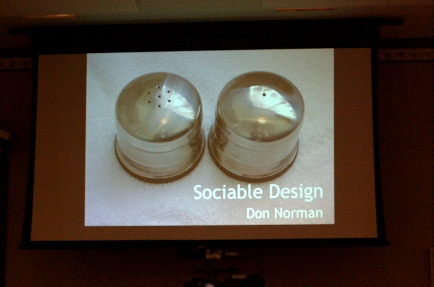
HP 8405A
A recent find.

3 ball
As I have written before (in the old WordPress version of the blog which I will eventually import into the present one), I have spent about the last six months learning to play pool. This has been a fascinating experience. We have a player in our league who is almost always disruptive and socially a misfit. But, he’s a phenomenal shooter. He throws three sheets to the wind, takes absurdly low-probability shots, and makes them with frightening regularity. Why? I suspect it’s because he not only has the skill to make shots, he’s confident that it’s the right shot to take. In the Scientific American article The Expert Mind, Philip Ross quotes chess master José Raúl Capablanca as saying, “I see only one move ahead, but it is always the correct one.” This is also the root of the “don’t second-guess yourself” on standardized tests and the thesis of Malcolm Gladwell’s book Blink.
It would be hubris to suggest that confidence alone yields success (look no further than the White House for a counterexample). However, the combination of experience, analysis, and confidence, act in synergy to produce results. The challenge is to create an environment or a curriculum that prepares confident students without watering-down the process. Confidence in engineering education is not limited to simply being confident that you can solve a given homework problem. Confidence is understanding how you and your education fit into the engineering process.
Perhaps the most important take-home lesson for engineering educators is to subject yourself to humbling learning experiences from time-to-time. This would make all of us better teachers.
» Read more: Playing Pool: Implications for Engineering Education

Don Norman slide
Donald Norman spoke as a part of the Design Matters lecture series at UIUC on Tuesday. Here are a few notes from his talk.
The traditional design approach creates a one-to-one mapping between user(s) and a machine or service. However, it neglects the environment. One particularly egregious example is what Norman calls “machines that moon us.” For instance, computers are designed to look good from the user standpoint. However, if the back of the computer faces the customers or a glass wall, more people can see the mess of wires behind the computer than the well-designed part.
“Social signifiers” are trails that people leave behind. For instance, if we arrive at a subway station and the platform is full of people, it is likely that we are early for the next train. On the other hand, if we arrive and the platform is vacant, it is likely that we are late. Fascinating.
Organic processes tend to be asynchronous. Therefore, waiting is unavoidable in the real world. The goal is to make the wait interesting and engaging for the user. More on this at a later date.
In other news, two interesting Design Matters lectures are on the horizon. David Goldberg of the iFoundry initiative to modernize engineering education at UIUC is speaking on 4 November. The second one is actually someone I considered suggesting to the series but dismissed as a long shot…Nokia designer/ethnographer/anthropologist Jan Chipchase, whose fascinating blog is in my blogroll, is coming on 2 December!
Just some miscellaneous news from happenings over the past month…first, the good news…
I passed the oral exam on Tuesday. So, I’m officially ABD now. There is a light at the end of the tunnel.
Nikon released the 50mm f/1.4G AF-S SWM prime lens at the end of September. I guess I wasn’t paying close enough attention. This is good news for D40 owners such as myself. But, the price is almost as steep as the Sigma f/1.4 30mm and 50mm HSM lenses. The 30mm lens would be a better all-around choice. Perhaps Nikon will come out with something a little shorter by the time I’m ready to buy. Until then, I’ll keep using the 50mm f/1.4 AF-D that I have on indefinite loan from work.
I managed to destroy the drivers in my recently-repaired TS-930S. I considered swapping the drivers from my second radio into this one. But, when I took that radio apart, I found that the capacitors had swollen. So, I have parts on order to fix that. UPS says they’ll be here today. I requested a quote for the NTE236 replacement for the MRF-485 drivers. They want almost as much for the NTE236 as RF Parts does for the MRF-485. I think I’ll get the MRF-485s.
We had high winds yesterday (Sunday). I lost the 80-, 40-, and 20-meter dipoles. Sarah said, “Do you expect that (80-meter) antenna to last the winter? It just broke in September.” She’s right. I’m not sure I’ll repair it if it breaks again. It’s less than a week to the CW Sweepstakes and I only have one working radio (FT-840) and antennas for 10 and 15 meters. The forecast calls for 65 and sunny on Thursday. So, I’ll probably take the day to work on antennas.
I’m a tinkerer. I’ve collected some basic test equipment and tools that allow me to work on many things, mostly electronic and mechanical. I have a cheap digital multimeter; but, the rest of my test equipment, like the HP 3310A function generator pictured above, is analog. Unlike digital equipment, where it’s no big deal to add extra digits to a read-out, analog equipment usually offers no more precision in its read-out than it’s capable of resolving.
Recently, I was talking to the guy who was the grader for an RF circuits class I took a few years ago. He was telling me how amazed he was that students would calculate the required inductance for an inductor to five digits of significance. And, they would write it in scientific notation: 3.1562E-6 Henries. We laughed. Nobody can make an inductor that precisely! Yet, we can calculate (and often measure) it that precisely. Tinkering, the process of getting something working, often does not require great precision. Sometimes that’s easy to forget when you have a powerful computer and a lab full of pricey test equipment.
It turns out that a lot of things in life do not demand immense precision. Heck, we might be better off without digital precision…
My father-in-law is an avid reader of Consumer Reports. He got us a subscription a while back. I frequently let Sarah read and summarize new issues. But, a new issue arrived today touting their latest computer evaluations. I was compelled to read it. By the way, the MacBook and the ThinkPad still top the list of laptops. At least someone agrees with my sentiments there.
As the son of an physicist who used to do performance testing for a major home appliance manufacturer that was not always treated favorably by CR, I have a healthy skepticism for the reviews. (It’s very easy to design experiments that favor certain outcomes.) Although, they frequently tend to bear-out my own recommendations and choices upon things I consider myself an expert about.
But, I digress. In the February 2008 issue, they spent some time on investments. One of the investments they recommended avoiding was an annuity. In the latest (June 2008) issue, an advertisement touts a “Consumer’s Union Annuity.” I didn’t bother to read the details, though. It seems that an investment in CR‘s parent company is fine, despite the earlier discouragement. Ok, so this is a relatively minor inconsistency. But, it never hurts to know what influence a buck has…
I just finished reading Robert Young Pelton‘s Licensed to Kill: Hired Guns in the War on Terror. It’s a pretty well-balanced look at the face of the modern mercenary that should easily let you draw your own conclusions about “the business.” Toward the end of the book, Pelton recounts a meeting he attended between the energetic chairman of one large, infamous, U.S. security contractor and representatives from a British counterpart firm. The British, Pelton reminds the reader, have a long history of counterinsurgency experience (including the birth of the U.S., I might add). At the end of the meeting, after the American has bragged on his weapons R&D, one of the British men parts with the following words, “It’s the application of minimum force.”
The entire book was worth reading for this sentence. It is a brilliant statement that tends to be lost on most of us, not just in terms of military action. A friend in college used to talk about how the school football and wrestling coaches liked farm boys because they were often deceptively strong. I told him that I suspected “farmer strength” tends to come from a lifetime of having to move things. Familiarity with your work environment makes you a better worker. I used to do plenty of framing work, mostly with Habitat for Humanity. One of my favorite parts of home construction is hanging trusses. Walking on walls is like ice skating or walking barefoot on sharp gravel or hunting or conducting a tense meeting or traveling in a foreign country or driving on snow. Make one quick move and you’ll fall. Acceleration, literally the result of an unbalanced force, is perilous.
New personal goal: Practice more finesse and less brute force. Apply minimum force.
One of the curses of attempting (I say ‘attempting’ because I’m mostly a failure) to be a “sustainable consumer” of electronics and appliances is the inevitable repairs. My venerable desktop PC of 8.5 years (known affectionately by it’s hostname “sakhalin”) is finally showing its age. It has trouble finding the boot drive from time to time. The “A radio” TS-930S doesn’t transmit on SSB anymore (this is a long-standing problem I have yet to diagnose), which is unfortunate because it has the roofing filter and Inrad SSB filters. The power nozzle for our Hoover canister vacuum cleaner needs an agitator belt. I need to find a local vacuum repair shop because none of the big stores carry the right size. I think Sarah would be just as happy to replace it with an upright. But, the canister still works! I wrecked the airplane a couple of weeks ago when the weather was not quite nice enough to be flying it. Fortunately, I have $3 worth of MacGuyver parts and epoxy that should be sufficient to make that repair. The wind broke one of the wires on my open-wire 80-meter dipole. (Finally, I reached the point of “if it stayed up last winter it’s not big enough.” The proof is in the performance, too.)
I’ll probably get the airplane and the antenna fixed yet this afternoon. The other problems are more long-standing. The desktop PC isn’t really necessary, especially since Sarah will be getting a laptop with her new job. So, I really probably could let it go. I still have the Pentium 166 that I bummed off of Dad for a contesting computer. It’s working great. But, do I unload the newer, superior computer that’s flaky? I have been tempted to dump the 166. I should try a new hard drive in sakhalin. Then there’s Sarah’s desktop…I can count on one hand the number of times it’s been turned on since we got married and I was the one using it! I’m holding onto Alan’s PowerBook because it’s the only place I have Adobe CS2. And, I have the ThinkPad “contesting laptop” that Ryan gave me when I got married… I guess if I weren’t such a tightwad and Mac-addict, I wouldn’t have this problem! No more junk!
We have five CRT’s in the house…two Dell 19″ Trinitrons on my desk, Sarah’s 17″ un-Trinitron Dell, my oscilloscope, and the TV. I’m not planning to replace the ‘scope or the TV anytime soon. So, I guess it’s the computers are the ones that will have to go…I just can’t let go of my junk… And, I went out and bought a new camera…sigh.
Recently the popular news has picked up a story about a paper in the journal Nature from December 2007. The article invokes a crude online survey of academics and scientists about their use of prescription medications like Ritalin as concentration aids. One of the respondents thought that it was his duty to be as “productive” as possible during his lifetime of “humane service.” My diagnosis is an acute case of self-importance.
Medication is often prescribed or taken as a substitute for lifestyle changes. While lifestyle doesn’t always help, it deserves more credit than it gets. For instance, a friend from college always used to wait until the last possible minute to complete his assignments. Invariably, he did as well or better than the rest of us. He spent most of his time doing whatever it was that interested him at the moment and then blitzed the homework. Brilliant. If what you’re doing isn’t important enough to capture your focus, you’re not doing the right thing.
Case in point: contesting with SO2R. You need contact volume to win a contest. But, pushing F1 isn’t that interesting after the rate slows. You also need multipliers to win a contest. This is hard work; but, it’s more engaging than running. If you do both at the same time, it increases your overall productivity. A fundamental shift in strategy produces a performance gain.
Improvement requires effort and creativity, not a pill.
Noted engineer and failure analyst Henry Petroski spoke recently as a part of the Design Matters series of lectures at UIUC. He has distilled millenia of human innovation into the following short sentences:
Perfection does not exist.
Form follows failure.
Criticism leads invention.
Design begets design.
Good betters best.
Problems persist.
Invention thrives.
Technology evolves.
I’m not sure there’s much I can possibly add to that…